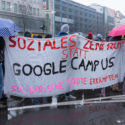Tag: Räumung Gerhart-Hauptmann-Schule
-

Kundgebung & Demo zur Räumung der Ohlauer/GHS, 11.01.2018, 7:45
Räumung der GHS am 11.01.2018 – Solidarität mit den Bewohner_innen. Eviction of GHS, 11.01.2018 – Call for solidarity Die Chronologie der GHS auf Deutsch und Englisch Pressestatement der Nachbarschaftsinitiative Ohlauer Straße (NIO), 19.7.2017: Wir kennen die beteiligten Menschen, wir respektieren die Umstände, wir erinnern die Absprachen Solidaritätsaufruf Andere Zustände ermöglichen (*aze) ____ DEUTSCH (English, French,…
-

Aufruf zu Solidarität mit den Bewohner*innen der Gerhart-Hauptmann-Schule
Englisch/Französisch below Bewegungsfreiheit statt Staatsgewalt! Aufruf zu Solidarität mit den Bewohner*innen der Gerhart-Hauptmann-Schule Am 11. Januar soll die Gerhart-Hauptmann-Schule geräumt werden. Es ist zwar in den letzten drei Jahren etwas ruhiger um die Ohlauerstraße geworden, aber die Relevanz der Kämpfe dieser Gruppe ist nach wie vor groß. Lange vor der ‘Willkommenskultur’ zeigte der March…
-
Gerichtsverhandlung über die geplante Räumung der Gerhart-Hauptmann-Schule.
english below Wortbruch von Bezirk und Senat ist illegal! You can’t evict a movement! & you can’t evict the school! 12.11.14 9.30 – 11 Uhr Möckernstraße 130
